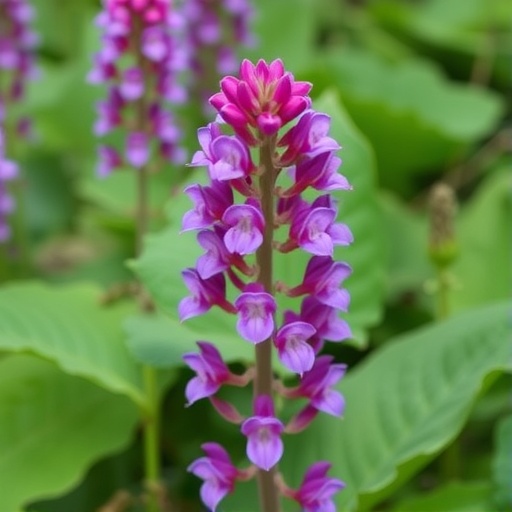In a groundbreaking study published in International Microbiology, researchers have unveiled how the dynamic interactions within microbial communities play a pivotal role in the diverse chemical composition found in the medicinal plant Salvia miltiorrhiza. This plant, widely recognized for its therapeutic properties, particularly in cardiovascular diseases, has piqued the interest of botanists and pharmacologists alike. The team’s exploration into the microbial flora associated with Salvia miltiorrhiza has led to startling revelations that could transform our understanding of plant-microbe interactions, particularly in enhancing the medicinal quality of plant species.
Salvia miltiorrhiza, commonly known as Danshen, has long been celebrated in traditional Chinese medicine for its potent bioactive compounds such as tanshinones and salvianolic acids. These compounds are credited with various pharmacological effects, including anti-inflammatory, antioxidant, and cardioprotective properties. As the global demand for natural medicines escalates, optimizing the active compound yield in such herbal plants through biotic factors, particularly microbial communities, poses an attractive avenue for research and application.
The study carried out by Chen et al. emphasizes that plant-associated microbes are not merely passengers; rather, they actively shape the biochemical landscape of their host. By examining the shifts in microbial communities in different growing conditions, the study highlights how these microorganisms can influence the quantity and quality of the bioactive compounds synthesized by the plant. This research emphasizes the complex interplay between plant metabolism and microbial ecology, shedding light on a previously underexplored aspect of botanical sciences.
To elucidate their findings, the researchers used advanced sequencing technologies to profile microbial communities residing in the rhizosphere of Salvia miltiorrhiza. They discovered a remarkable variation in microbial biodiversity correlated with the plant’s active compound composition. Specifically, certain bacterial species demonstrated a capacity to enhance the production of key markers of medicinal efficacy. Through this lens, the study posits that manipulating microbial communities could offer a biotechnological strategy to boost the medicinal value of Salvia miltiorrhiza.
Moreover, the implications of these findings extend beyond mere plant enhancement. They suggest a paradigm shift in how researchers and cultivators perceive the management of medicinal plants. While growing conditions such as soil type, light, and water are essential, the authors assert that integrating microbial health into cultivation practices could yield unprecedented advancements in plant secondary metabolite production. By fostering beneficial microbes in the soil, cultivators might maximize the therapeutic potential of their crops, thus catering to the growing market for potent natural remedies.
The authors also point out that the variations within microbial communities can be experimentally manipulated. Techniques such as microbial inoculation or the application of specific fertilizers that promote advantageous microbial populations could become standard practices in sustainable agriculture. The study proposes further investigation into the potential for specific microbial strains to enhance the biosynthesis of target compounds, marking a new frontier in the field of ethnobotany.
In an era defined by the search for sustainability and eco-conscious practices, this research aligns seamlessly with contemporary scientific inquiries. Developing a deeper understanding of plant-microbe interactions could lead to more sustainable production systems for medicinal plants. The concept of enhancing plant properties via microbiomes underscores the intricate connections in ecosystems, encouraging a holistic perspective on cultivation and conservation.
As science continues to unveil the complexity of life on Earth, understanding the role of microbial communities in plant health becomes increasingly critical. The detailed insights gathered from this study could forge pathways for innovative agricultural practices while simultaneously enhancing our comprehension of biodiversity. Such advancements could significantly impact health care, particularly as the world increasingly turns to herbal medicine and natural products for holistic care solutions.
In conclusion, Chen et al.’s research paints a vibrant picture of the potential held within the microbial world. By demonstrating that microbial diversity can directly influence the quality of secondary metabolites in Salvia miltiorrhiza, they have opened doors to innovative cultivation techniques that promise to make medicinal herbs more effective and accessible. This work not only deepens our understanding of botanical pharmacology but also provides a compelling argument for the preservation and enhancement of microbial diversity as a vital component of agricultural sustainability and health.
As further research unfolds in this area, we may soon see practical applications of these findings making a tangible difference in the lives of those dependent on herbal medicine. The intersection of microbiology and herbal sciences is likely to yield exciting developments in the near future, with applications that can lead to healthier, sustainable, and more effective natural health solutions.
In a world striving for sustainable agricultural practices, this research might serve as a guiding light, encouraging future studies that prioritize the significance of invisible partners in our ecosystems. The quest to unlock the full potential of medicinal plants has never been more crucial, and the microbial communities living alongside these plants could very well hold the key to their success.
Subject of Research: Microbial community variation in Salvia miltiorrhiza
Article Title: Microbial community variation enhances active compound composition in Salvia miltiorrhiza
Article References: Chen, Z.l., Du, H.z., Wang, J.k. et al. Microbial community variation enhances active compound composition in Salvia miltiorrhiza. Int Microbiol (2025). https://doi.org/10.1007/s10123-025-00700-4
Image Credits: AI Generated
DOI: https://doi.org/10.1007/s10123-025-00700-4
Keywords: Salvia miltiorrhiza, microbial communities, active compounds, medicinal plants, botany, pharmacology, sustainability, herbal medicine.




